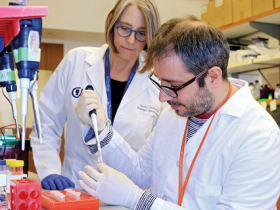It has long been believed that a person’s propensity for hypnosis is a fairly fixed characteristic. You might fall into the about 25% of persons who are truly incapable of being hypnotized, or you might be someone who is extremely hypnotizable. The results of a 25-year study showed that hypnotic susceptibility was an exceptionally stable feature. Similar to personality and IQ, the attribute is rather stable over time, independent of life circumstances.
However, a group of Stanford University researchers has recently found a means of increasing hypnotic susceptibility. The discovery could alter the way hypnosis therapy is delivered. The researchers were able to increase a subject’s responsiveness to hypnosis by using focused, non-invasive neurostimulation.
“Backpack”-wearing cells reduce traumatic brain injury lesions by 56%.
David Spiegel and others at Stanford University have been studying hypnosis for a number of decades. The research endeavored to focus on the neurological underpinnings of efficacious hypnosis therapy in addition to investigating its potential applications in treating conditions such as addiction and chronic pain. In essence, the goal of the research has been to determine why certain people’s brains are more prone to hypnosis than others.
A 2016 study comparing brain activity between a highly hypnotizable cohort and a control group with limited sensitivity to hypnosis revealed one of Spiegel’s more significant discoveries. The study discovered that functional connectivity between the dorsal anterior cingulate cortex and the left dorsolateral prefrontal cortex was one of the main characteristics that appeared to influence hypnotic susceptibility.
Information processing and stimulus detection are balanced in these two brain areas. Spiegel further claims that a person’s capacity to concentrate on directions under hypnosis is more successful the more connected these two regions are.
Spiegel said that ,“It made sense that people who naturally coordinate activity between these two regions would be able to concentrate more intently,” “It’s because you’re coordinating what you are focusing on with the system that distracts you.”
Therefore, it made sense for the researchers to investigate if it would be possible to increase the functional connection between certain brain regions. Here, Spiegel teamed up with transcranial magnetic stimulation (TMS) specialist Nolan Williams, who specializes in non-invasive brain stimulation for specific regions of the brain.
The investigators recruited eighty fibromyalgia patients. Every participant received a rating of either moderate or low hypnotic susceptibility. While the other half of the cohort received a sham treatment, the other half of the cohort received a brief TMS burst to the left dorsolateral prefrontal cortex. The patients had a hypnotherapy session immediately following the treatment, with a focus on their chronic pain condition.
By measuring hypnotizability using well accepted measures, the researchers discovered that the TMS-receiving patients had far higher scores for hypnotic susceptibility. What’s even more intriguing is that, after an hour or so, the effect subsided and the scores for both groups returned to normal.
Williams stated, “We were pleasantly surprised that we were able to change a stable brain trait that people have been trying to change for 100 years with just 92 seconds of stimulation.” “We finally cracked the code on how to do it.”
Lead author Afik Faerman is enthusiastic about the potential opportunities presented by this type of therapy-enhancing neurostimulation, even though a little more research is necessary to fully grasp how this treatment could be maximized. Faerman suggests that other stable traits might be altered if a stable trait like hypnotizability can be enhanced by neurostimulation. Or perhaps this type of care could just make basic psychotherapy more effective?
“As a clinical psychologist, my personal vision is that, in the future, patients come in, they go into a quick, non-invasive brain stimulation session, then they go in to see their psychologist,” Faerman muses. “Their benefit from treatment could be much higher.”















